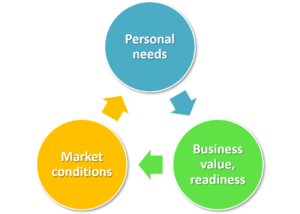Buy-Sell agreements (BSA’s) are an essential, and often overlooked, element in allowing shareholders to realize the value of their investment in a privately held company. The BSA’s purpose is to a) provide a market for ownership interests, b) establish the price and terms for these interests, c) specify a buy-sell process that is orderly and reasonable, and d) specify financing should a “trigger” event occur. There are several reasons this contract among owners can fail. Let’s briefly examine a few reasons why this can occur and it will become obvious why this document needs to “live and breathe” outside the confines of the corporate archives.
A BSA that is written upon entity formation, even if well-articulated, becomes less relevant as time marches on. This happens for myriad reasons ranging from changes in business conditions and value, or changes in an owners personal situation or objectives. Language in BSA’s is often not sufficiently precise and leaves too much room for interpretation that can result in shareholder disputes and costly litigation that dilutes value for all shareholders.
There are three types of BSA’s: fixed price; formula pricing; and valuation process. Business valuation is a function of economic conditions and business fundamentals. Of the three BSA types, only the valuation process is flexible enough to fully accommodate the range of changes that can occur in a business. Fixed price and formula driven valuations may be less expensive to execute, but they are simplistic and can omit key value determinants that ultimately can prove very costly.
There are a wide range of trigger events where an owner may quit, be fired, retire, die, be disabled, or get divorced to name only a few. Each trigger event can alter the personal objectives of one or more owners, impact the business, and may have both control and valuation implications for all concerned parties.
Template-driven BSA’s frequently either omit, or do not make a clear distinction on the standard of value to be used in calculating value. For example, the difference between using an investment value standard or a fair market value standard can be very large. If the standard is not clear in the BSA, a buyer would naturally assume the lower price implied in the fair market value standard, while a seller would assume the higher price found in the investment value. Hence, if the BSA does not clearly address this issue, conflict and costly litigation is a likely outcome. Similarly, the level of value also has valuation implications that create potential for conflict if not clearly addressed in the BSA, because the difference between a controlling interest and a minority interests can be substantial.
As is now readily apparent, a well-defined and current BSA is important to accurately allocate value and keep the peace! Key elements of the BSA should seem reasonable to all owners BEFORE a trigger event (before the parties know if they will be a buyer or a seller), when it is easier to reach consensus. AFTER a trigger event this becomes difficult since there is an inherent conflict between a buyer and a seller.
Business valuation plays a central role in Buy-Sell Agreements. For more information about Exit Strategies’ BSA-related services contact one of our senior business appraisers.

 Going to market when you and your business are ready to sell and market conditions are right provides the best opportunity to maximize results. Let’s look at how these three ingredients combine:
Going to market when you and your business are ready to sell and market conditions are right provides the best opportunity to maximize results. Let’s look at how these three ingredients combine: Most business acquisitions by private equity firms have been “add-on” deals lately.
Most business acquisitions by private equity firms have been “add-on” deals lately.

